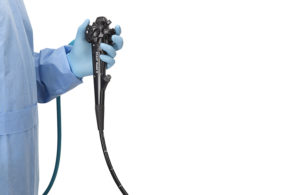FDA wanted single-use scopes to reduce potentially deadly superbug infections. Here’s how Boston Scientific made it happen.

The Exalt Model D [Image courtesy of Boston Scientific]
Boston Scientific’s Exalt Model D Single-Use Duodenoscope received FDA clearance in December 2019. It was the first device of its kind to hit the medical market. Just five months earlier, the FDA urged device manufacturers to move away from re-usable duodenoscopes with endcaps that were more difficult to clean and led to “superbug” infections in 1 in 20 cases. As it so happened, Boston Scientific was already working on a single-use scope.
Now on the market, Exalt is making its way into physician’s offices, but it was a complicated journey.
Boston Scientific’s chief medical officer Dr. Brian Dunkin recently told Medical Design & Outsourcing that the company overcame five challenges to make Exalt a reality:
1. Predicting the future.
“The whole impetus for developing this technology came out of the observation in the endoscopy community of some outbreaks of infections in patients,” Dunkin said. Researchers knew the outbreaks were from drug-resistant organisms, but they didn’t have the data to understand the gravity of the problem. “We had to predict the future a little because that data was coming in through different avenues, and it was entirely possible that it would say, ‘It’s not really a big problem.’ “
That didn’t turn out to be the case. The FDA wanted to move away from reusable scopes because in 5.4% of cases, scopes contained “superbugs” that led to infection.
2. Design requirements
Boston Scientific’s design process was daunting: Some 150 doctors helped design a scope that went through 9,000 iterations. When complete, the processor connected to the camera box contained 2,000 parts, and the scope itself had more than 150. It took six manufacturing facilities and a development team of 200 to build the device.
In simplest terms, Dunkin put it like this: “We need to make this work like a state-of-the-art reusable scope, and turn it into a single-use device.”
Boston Scientific also had to solve the intricacies of how the device navigates during endoscopic retrograde cholangiopancreatography (ERCP), a demanding procedure that requires a specialized scope that has different features.
“It doesn’t look just front way, it looks sideways, so has different lens angles. It has an elevator mechanism so that when we put tools through it, we can move those instruments in a much more refined fashion,” Dunkin said.
Dunkin added that there was another important consideration: “If it changes my technique as an endoscopist, I’m not going to adopt it.”
So Boston Scientific talked to experts, asking, “Is this right? Is that right? We had to make our own model of ERCP because nobody had one out there that you could use. Is an inanimate model to test the device,” Dunkin said. And then Boston Scientific tested in animal labs and eventually in humans to make sure it performed as expected.
3. Cost
Boston Scientific officials considered all the costs associated with reusable scopes — like cleaning, training, and monitoring — and factored that into creating a single-use device with a strong value proposition.
“If cost is similar to what a reusable scope costs, that’s not going to help you necessarily — because I don’t throw that scope away every day,” Dunkin said. To strengthen that proposition, Boston Scientific worked with CMS so that doctors get extra reimbursement for outpatient procedures. The company has a similar proposal pending for inpatient care.
“You will actually get paid to use that scope. You’ll get an additional payment to offset the cost of that scope. That is, to us, an indication that Medicare has made a decision that, ‘We think this is a significant enough problem that we want our patients managed with this technology.’”
4. Performance
In short, it’s got to work and work well.
“You got to make the device that can do the job, not compromise the procedure and cause patient problems. And then you’ve got to convince people that it can do the job, and they have to see the value in that,” Dunkin said.
5. Professional development
Boston Scientific quickly figured out it didn’t need to train people in ERCP; it needed to get health providers to understand the infection problem. “It’s very likely that I could have the impression that I’ve never seen a patient with an infection from a contaminated scope,” Dunkin said.
But he noted the infections don’t present immediately and could take weeks or months to show up in patients. The infection might even show up in an area that has no immediate connection to ERCP. The healthcare community needed to better understand the infection problem and the need to transition to new technology
For those looking to turn a device into a single-use model, Dunkin had this advice: “You’ve got to get those design requirements right and you got do that iteratively with the experts that you work with so that you don’t waste time going down false pathways that aren’t going to get you where you need to go.
Ray Marcano is a long-time journalist who started his career covering health and medicine. He’s the former president of the Society of Professional Journalists, a two-time Pulitzer juror, and a Fulbright Fellow.